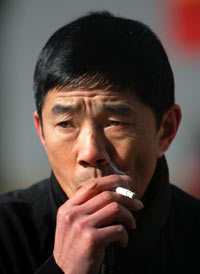|
China to ban new cigarette factories
(Reuters)
Updated: 2006-02-08 16:32
China will not allow new cigarette factories, including joint ventures with
foreign partners, as part of efforts to reduce smoking in a country that puffs
its way through almost 2 trillion cigarettes a year.

A Chinese man
smokes a cigarette in China's capital Beijing February 8, 2006. China will
not allow any new cigarette factories or joint ventures with foreign
companies for tobacco production as part of efforts to reduce consumption,
state media reported on Wednesday, quoting a Chinese official.
[Reuters] | Beijing would also impose strict
controls on existing tobacco production, including taxes on tobacco leaf and
industry reorganisation, Xinhua news agency quoted Sha Zukang, the ambassador to
U.N. agencies in Geneva, as telling a conference.
China is the world's
largest cigarette producer and Chinese are the world's most enthusiastic
smokers, with a growing market of about 320 million making it a magnet for
multinationals and focus of international health concern.
Chinese
cigarettes are also among the cheapest in the world -- a packet can cost as
little as 8 U.S. cents -- and smoking kills 1.2 million people a year in China,
according to the World Health Organisation.
In December, Philip Morris,
a unit of Altria Group Inc. , announced a joint venture to produce Marlboro
cigarettes in China. Its partner is state-owned China National Tobacco Corp.
Sha's promise echoed past comments by Chinese health officials,
including some by a spokesman for the country's State Tobacco Monopoly
Administration early in 2005, and it was unclear how the Philip Morris deal
would be affected.
Philip Morris declined comment, apart from re-issuing
a statement from last December announcing the China deal.
Sha was
speaking at a meeting on implementing the WHO's Framework Convention on Tobacco
Control, which China signed in 2003 and ratified in 2005. The convention aims to
reduce tobacco consumption, including through a ban on advertising and
promotion.
"The Chinese government will follow the relevant stipulations
of the convention to improve its related laws and regulations, strictly control
smoking in public spaces and strengthen regulation of tobacco production and
business activities," Sha said.
The WHO said the convention's measures
could help save 200 million lives by 2050 if they achieve the goal of cutting
smoking and fresh recruits to smoking by a half.
But it added there was
still a long way to go to cut tobacco use in China despite the government's best
intentions.
"In many cities, and in many public areas, on paper smoking
is not allowed, but you see even in hospitals some people still smoke," said
Cristobal Tunon, WHO senior programme management officer in Beijing, who works
on anti-smoking efforts.
"It's a social practice, and we need to change
mind sets here to make it an anti-social practice," he added. "You cannot just
solve it by waving a magic wand."
Chinese tobacco industry officials have
said they will implement the international convention, but they have also
outlined plans to make the country's cigarette makers more efficient and to
consolidate the fragmented domestic market.
Jiang Chengkang, the head of
the State Tobacco Monopoly Administration, told a January 14 meeting of tobacco
officials that China would focus on developing 10 main cigarette brands and
improving production technology, according to the bureau's Web site (www.tobacco.gov.cn).
"Tobacco leaf
production continues to maintain steady development," Jiang said, noting that
taxes from the tobacco industry grew more than a tenth in 2005 to 159 billion
yuan ($19.74 billion) -- around 5 percent of total tax revenues.
In
2005, Chinese consumers bought 1.947 trillion cigarettes, an increase of almost
4 percent, he added.
($1=8.055 Yuan)
|